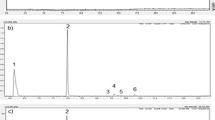Abstract
Laboratory olfactometer bioassays were used to study attractiveness of whole animal wounds, wound fluid, and reconstituted dried blood to gravid screwworm flies,Cochliomyia hominivorax (Coquerel). Flies were attracted to odors from whole wounds that were infested with screwworm larvae but not to those from uninfested wounds that were 0–2 days old. A maximum of 59% of females were attracted to fluid from screwworminfested wounds, and the response changed little over fluid concentrations from 3.3 to 100%. However, blood tested over a similar concentration range yielded a significant linear relationship between log dose and response. Peak attraction was 82%. Attractancy of fluid collected from infested wounds declined when the fluid was stored at − 20 °C for more than four weeks but attractancy of a stored blood sample remained unchanged for three months. The blood attractant(s) was also heat stable and is suitable for use as a reference standard in bioassays.
Similar content being viewed by others
References
Adams, T.S., Holt, G.G., andSundet, W.D. 1979. Physical and physiological effects on the response of female screwworms,Cochliomyia hominivorax (Diptera: Calliphoridae) to carrion odors in an olfactometer.J. Med. Entomol. 15:124–131.
Borgstrom, F.A. 1938. Studies on experimentalCochliomyia americana infestations with special reference to the bacterial flora and the development of immunity.Am. J. Trop, Med. 18:395–411.
Bushland, R.C. 1960. Screwworm research and eradication.Adv. Vet. Sci. 6:1–18.
Coppedge, J.R., Ahrens, E., Goodenough, J.L., Guillot, F.S., andSnow, J.W. 1977. Field comparisons of liver and a new chemical mixture as attractants for the screwworm fly.Environ. Eniomol. 6:66–68.
DeVaney, J.A., Eddy, G.W., Handke, B.D., andLofez, E. 1970. Olfactory responses of the adult screwworm after removal of the antennae, mouthparts, tarsi, and legs.J. Econ. Entomol. 63:1816–1819.
DeVaney, J.A., Eddy, G.W., Ellis, E.M., andHarrington, R., Jr. 1973. Attractancy of inoculated and incubated bovine blood fractions to screwworm flies (Diptera: Calliphoridae): Role of bacteria.J. Med. Entomol. 10:591–595.
Eddy, G.W., DeVaney, J.A., andHandke, B.D. 1975. Response of the adult screwworm (Diptera: Calliphoridae) to bacteria-inoculated and incubated bovine blood in olfactometer and oviposition tests.J. Med. Entomol. 12:379–381.
Esslinger, J.H. 1958. Effects of the screw-worm on guinea pigs.J. Parasitol. 44:201–209.
Grabbe, R.R., andTurner, J.P. 1973. Screwworm attractants: Isolation and identification of organic compounds from bacterially inoculated and incubated blood.Folia Entomol. Mex. (abs.) 25–26:120–121.
Guillot, F.S., Brown, H.E., andBroce, A.B. 1977a. Behavior of sexually active male screwworm flies.Ann. Entomol. Soc. Am. 71:199–201.
Guillot, F.S., Coppedge, J.R., Goodenough, J.L., Adams, T.S., andAhrens, E. 1977b. Behavior and reproductive status of native female screwworms attracted to a host.Ann. Entomol. Soc. Am. 70:588–590.
Guillot, F.S., Coppedge, J.R., Goodenough, J.L., Ahrens, E., andAdams, T.S. 1977c. Reproductive status of female screwworms captured from hosts or in traps.Southwest. Entomol. 2:49–52.
Holt, G.G., Adams, T.S., andSundet, W.D. 1979. Attraction and ovipositional response of screwworms,Cochliomyia hominivorax (Diptera: Calliphoridae), to simulated bovine wounds.J. Med. Entomol. 16:248–253.
Jones, C.M., Oehler, D.D., Snow, J.W., andGrabbe, R.R. 1976. A chemical attractant for screwworm flies.J. Econ. Entomol. 69:389–391.
Knipling, E.F. 1979. The Basic Principles of Insect Population Suppression and Management. USDA Handbook No. 512, 659 pp.
Knipling, E.F., andTravis, B.V. 1937. Relative importance and seasonal activity ofCochliomyia americana C&P.J. Econ. Entomol. 30:727–735.
Melvin, R., andBushland, R.C. 1940. The nutritional requirements of screwworm larvae,J. Econ. Entomol. 33:850–852.
Parish, H.E. 1937. Flight tests on screwworm flies.J. Econ. Entomol. 30:740–743.
Steel, R.G.D., andTorrie, J.H. 1960. Principles and Procedures of Statistics. McGraw-Hill, New York, 481 pp.
Author information
Authors and Affiliations
Additional information
Mention of a company name or proprietary product does not imply an endorsement by the U.S. Department of Agriculture.
Rights and permissions
About this article
Cite this article
Hammack, L., Holt, G.G. Responses of gravid screwworm flies,Cochliomyia hominivorax, to whole wounds, wound fluid, and a standard blood attractant in olfactometer tests. J Chem Ecol 9, 913–922 (1983). https://doi.org/10.1007/BF00987814
Received:
Revised:
Issue Date:
DOI: https://doi.org/10.1007/BF00987814




